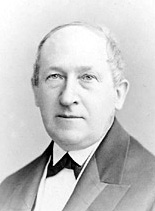Hermann Knoblauch
Karl Hermann Knoblauch (born April 11, 1820 in Berlin , † June 30, 1895 in Baden-Baden ) was a German physicist .
Life
Knoblauch was the son of the Berlin silk ribbon manufacturer Carl Friedrich Wilhelm Knoblauch (1793-1859). After attending the Cöllnisches Realgymnasium in Berlin, Knoblauch completed the pedagogy in Züllichau . Since he was supposed to take over the family business at the request of his parents, Knoblauch completed a commercial apprenticeship in Frankfurt am Main and also received private lessons. This enabled him to successfully pass the Abitur as an external student .
After some arguments with his family, Knoblauch was allowed to study mathematics , natural sciences and philosophy at the University of Berlin . His teacher Gustav Magnus soon allowed his best student to use his private laboratory. In 1847 Knoblauch successfully completed his studies with a doctorate on "Heat".
In parallel to his research, he qualified and passed the senior teacher examination in the same year. In 1848 he was able to complete his habilitation in physics and one year later got a job at the University of Bonn as a private lecturer. But already at the end of this year he accepted a position as aoProf. to the University of Marburg .
Knoblauch was appointed full professor there in 1852 . appointed. In 1853 he accepted a position at the University of Halle and taught there until the winter semester of 1894/95. In addition to his purely scientific work, he also worked as an organizer. In 1845 Knoblauch played a key role in founding the " Physical Society ". Between 1868 and 1871 he was entrusted three times with the office of rector of the university .
As such, he established several foundations and grants. Together with Peter Krukenberg's widow , he donated the renovation of the university auditorium . From 1873 Knoblauch belonged to the Prussian manor house. There he represented fairly liberal views, but was otherwise not politically active. In 1862 he became a member and in 1878 XV. Elected President (1878–1895) of the German Academy of Sciences Leopoldina . During his presidency, the course was set for the Leopoldina to settle permanently in Halle. The library, which had grown immensely in the meantime, required its own library building. In 1864 he was elected a corresponding member of the Göttingen Academy of Sciences .
He was mainly concerned with thermal radiation ( infrared radiation ) and demonstrated its nature as electromagnetic radiation in numerous experiments ( diffraction , interference , birefringence in crystals, etc.).
Knoblauch died in Baden-Baden, where he hoped to cure pleurisy during a cure. His grave is in the town of Halle . Today a street is named after him on the Weinberg Campus of the Martin Luther University Halle-Wittenberg.
Honors
- Red Eagle Order 2nd Class
- Order of the Crown 2nd class
- Order of Peace of Württemberg
- Golden Prussian Medal for Science and Art
Fonts
- De calore radiante disquisitiones experimentis quibusdam novis illustrate . - Berlin, Univ. Diss., 1847
literature
- Robert Knott: Knoblauch, Hermann . In: Allgemeine Deutsche Biographie (ADB). Volume 51, Duncker & Humblot, Leipzig 1906, pp. 256-258.
- Knoblauch, Karl Hermann . In: Meyers Konversations-Lexikon . 4th edition. Volume 9, Verlag des Bibliographisches Institut, Leipzig / Vienna 1885–1892, p. 875.
Web links
- Works by and about Hermann Knoblauch in the German Digital Library
- Entry on Hermann Knoblauch in the Catalogus Professorum Halensis
- Knoblauch, Carl Hermann. Hessian biography. (As of February 13, 2020). In: Landesgeschichtliches Informationssystem Hessen (LAGIS).
References and comments
- ^ Member entry of Carl Hermann Knoblauch (with picture) at the German Academy of Natural Scientists Leopoldina , accessed on November 25, 2015.
- ↑ Holger Krahnke: The members of the Academy of Sciences in Göttingen 1751-2001 (= Treatises of the Academy of Sciences in Göttingen, Philological-Historical Class. Volume 3, Vol. 246 = Treatises of the Academy of Sciences in Göttingen, Mathematical-Physical Class. Episode 3, vol. 50). Vandenhoeck & Ruprecht, Göttingen 2001, ISBN 3-525-82516-1 , p. 133.
| personal data | |
|---|---|
| SURNAME | Knoblauch, Hermann |
| ALTERNATIVE NAMES | Knoblauch, Karl Hermann |
| BRIEF DESCRIPTION | German physicist |
| DATE OF BIRTH | April 11, 1820 |
| PLACE OF BIRTH | Berlin |
| DATE OF DEATH | June 30, 1895 |
| Place of death | Baden-Baden |
